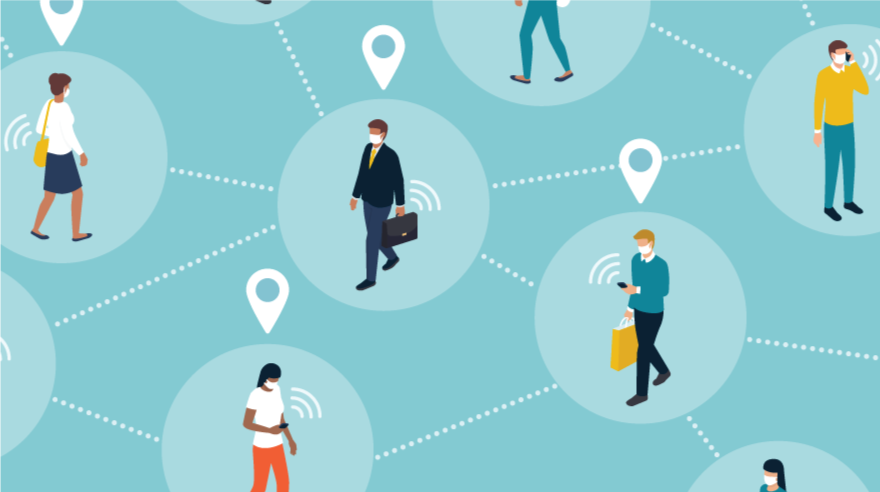How changes in contact tracing could prevent the spread of a new SARS-CoV-2 strain
BY: GINA MANTICA
Just this weekend, Massachusetts confirmed the presence of the more contagious strain of SARS-CoV-2, known as B-117. And without enough COVID-19 tests and contact tracers, current contact tracing methods might be insufficient in preventing its spread throughout the Commonwealth. But bidirectional contact tracing, or tracking positive COVID-19 cases both to newly infected individuals and back to their original source, can be twice as effective as current methods.

Boston University researcher Jonathan Huggins, an Assistant Professor in the Department of Mathematics & Statistics, worked closely with collaborators at Massachusetts Institute of Technology (MIT), North Carolina State University, and Max Planck Institute for Biology of Ageing to build a model that explores the effectiveness of bidirectional contact tracing. With Huggins’ computational expertise, the team was able to collect and analyze their results in just one month.
Their findings, recently published in Nature Communications, suggest that bidirectional contact tracing, though somewhat time-intensive, is more effective than both current contact tracing methods and digital COVID-19 exposure notifications. And, bidirectional contact tracing could help prevent the spread of the more infectious B-117 strain that has emerged from the United Kingdom.
Forward and Reverse Tracing
The researchers thought that bidirectional contact tracing could identify more people with COVID-19 than the common “forward tracing” method. Forward tracing identifies individuals that may have been infected by a known case. Bidirectional contact tracing adds “reverse tracing” to find the person that infected the known case, and then all of the individuals that original person might have infected.
“Bidirectional contact tracing isn’t just about finding the infector. It’s about finding all the other people that came into contact with this infector to have a big impact on controlling further spread,” said Huggins.
To test their prediction, Huggins and colleagues constructed a model of the spread of SARS-CoV-2 transmission that included not only the incubation period and contagiousness of the virus, but also the sensitivity of COVID-19 tests and average delays to both testing and contact tracing. The team also considered the number of people that could be asymptomatic carriers and these carriers’ infectiousness.
What the researchers found aligned with their predictions — bidirectional tracing is much more effective than forward tracing. And when the researchers altered their model to identify possible contacts from up to six days before the onset of symptoms rather than the usual 48 hours, bidirectional tracing became twice as effective as current methods in slowing the spread of COVID-19.
“The more people you find, the better contact tracing works,” said Kevin Esvelt, Huggins’ collaborator and Assistant Professor of Media Arts and Sciences at MIT. “If you cut off tracing at 48 hours, you might have issues finding the person that transferred the virus,” he said.

Digital Tracing
In practice, identifying four additional days’ worth of contacts is time-consuming. And finding the original “infector” by reverse tracing could make this process take even longer. But what if technology could help with tracing?
To test whether contact tracing could benefit from technology, Huggins and his collaborators incorporated “digital tracing” into their model. Digital tracing uses Bluetooth technology to track and record close interactions between infected individuals. Based on COVID-19 testing data provided by users, folks with smartphones would hear “chirps” when they’ve been near someone with the virus.
The researchers were surprised at the results: these digital exposure notifications didn’t seem to do much better than manual contact tracing in preventing the spread of COVID-19.
This could be because the team considered the fact that not everyone has a smartphone in their model, and even those that do might not input their testing data. “If not everyone has the notification system, the network of transmission becomes very fragmented and it is hard to do a significant amount of tracing,” said Huggins.
B-117
With just over 2,000 contact tracers in Massachusetts and over 5,000 new cases of COVID-19 daily, Huggins and Esvelt both suggest that contact tracing resources be diverted to stopping the spread of the more contagious B-117 variant. “We need to throw contact tracers at this new strain. You are still going to get an exponential spread of B-117 even when you have the original [SARS-CoV-2] strain under control,” said Huggins,

This new strain is a result of a mutation known as N501Y on the virus’ infamous spike protein. The mutation might make the virus better at binding to the human angiotensin-converting enzyme 2 (ACE2) receptor. Tighter binding might explain B-117’s rapid transmission rate, though there is no published research on this to date.
There are at least 14 states with reported B-117 cases in the United States, including Massachusetts, but CDC officials believe this number is an underestimation.
While there’s a lot that we don’t know yet about the B-117 strain, moving to bidirectional contact tracing could slow, or even prevent, its transmission. “If you do bidirectional tracing, you can prevent 40% of COVID-19 cases two months in the future even if only 50% of people comply with contact tracing procedures,” said Esvelt.
Interested in learning more about the transformational science happening at the Hariri Institute? Sign up for our newsletter here.
